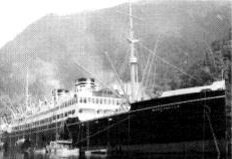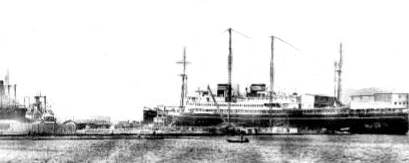Daylight made Wanganella’s plight more obvious. She had driven herself on to Outer Rock, mangling her bow and creating a gash some 40 by 22 feet (13 × 7m) for water to slosh in and out of her hull. Buoyancy forward was a thing of the past. An abortive attempt to tow her off made it evident that only a combination of restored buoyancy and a high tide could hope to release her from the reef’s fangs. Fuel oil was pumped out of her, then the two forward holds were to be sealed and compressed air blown into them; but only if the weather remained calm could this work be completed before her whole hull was wrenched apart.
Entering dock
And it did remain calm! ‘Wanganella weather’ became legendary, over the entire eighteen-day period until Thursday evening (6 February) when, after an earlier attempt a week before, she moved, then came free on the end of a line from the tug Toia. She was towed stern-first and heavily down by the bow, to end up, her bow on the harbour bottom, at Aotea Quay. Here she languished until the floating dock, occupied by another ship, became available, and it would be a couple of weeks before she entered dock, without tugs (they had gone on strike for higher wages) and with Darroch joined by Wellington’s deputy harbourmaster David Todd, who prided himself on his ability to handle ships without tugs. It was then the turn of the dock workers to demand higher pay, and to declare the ship ‘black’; and only temporary patching of her bow was possible so that shecould be towed back to Aotea Quay wharf on 27 May.
A great bite
During her time in dock it was determined that her bow, with a great bite out of it, was beyond repair, and a replacement bow would need to be prefabricated. This task was carried out by Harland and Woolf back in Belfast; the new structure extended over more than a third of Wanganella’s length, and its component parts were shipped out in Hororata, a large New Zealand Shipping Company cargo vessel that was herself a survivor: she was torpedoed as she approached the Azores on the homeward leg of her maiden voyage in 1942. Wanganella was returned to the dock in January 1948, and her precious replacement arrived in early March. It took until the end of October before the vessel could test the precision of the assembly process — one minor leak, sealed in a matter of hours as the dock was flooded, was found. Wanganella was towed back to Clyde Quay wharf, and the opportunity was taken to eliminate the remains of her wartime service; in particular, any remaining hospital green paint was covered up. After sea trials at the end of November, the ship left for Sydney on 9 December 1948, fully booked.
Back in service
Meanwhile, because he and Captain Todd had easedthe stricken vessel into a dock without a tug, the unfortunate Captain Darroch had faced a Court of Inquiry. This had found him negligent and, although his certificate was only suspended for three months, his career was effectively over. His only subsequent command was in 1952, of a small coaster, the Awahou, which disappeared without trace on a voyage to Lord Howe Island.
Wanganella herself fared much better, making regular weekly sailings in tandem with the Union company’s Monowai. With a refit in 1952, she remained popular and although her 1930s pattern squat motor ship funnels looked somewhat ‘dated’ (the forward one was a dummy, and nothing came of a proposal during that refit to transfer it to sit above the ‘working’ one) she was still trim in her Huddart Parker livery of black hull with a thin white band just below the white upperworks, and buff funnels. But air travel was becoming increasingly popular through the latter 1950s, and when in 1961 Huddart Parker was sold off and its fleet dispersed, Wanganella was bought by McIlwraith McEachern of Melbourne. Her name was retained, but her funnels were repainted in the black-topped red of her new owners, and she resumed her trans-Tasman schedule, managed now by the Union company, which had withdrawn Monowai from service the previous year.
New owners. Note dummy fore funnel
In mid-Tasman on a voyage from Sydney to Auckland, she showed her age in spectacular fashion. On 26 March 1962 a piston rod in her port engine snapped; the broken rod fell into the crankcase where, boosted by the rotating crank, it was spat out through the casing. At Auckland they cleared up the mess enough for her to return to Sydney on one engine, and here she spent April while proper repairs were made. The implications of this episode were enough for McIlwraith McEachern to decide to sell Wanganella just three days after the repairs were completed, and an engine room explosion and fire in June confirmed the wisdom of their decision.
After finishing her final voyage on 25 July, Wanganella was laid up in Sydney; on 15 August her new owners took her over, and she became the property of the Hang Fung Shipping and Trading Company of Hong Kong. She made one trip there to change funnel colours (to black with two silver bands) and port of registry, then returned to Auckland to undertake a Melbourne Cup cruise, which in turn led to other cruises round the Pacific and Australia, and then to a spell in November as a floating hotel at Fremantle during the 1962 Commonwealth Games. A few cruises in early 1963 followed, and there were grand schemes which came to nothing. Instead the ship was laid up in Sydney and offered for sale.
Then came the final, novel and quite unexpected phase in her career. The Manapouri power scheme planned for water from Lake Manapouri to enter a tunnel down to an underground assembly of turbines, from which it would discharge through a 10km tunnel into Doubtful Sound. Utah Construction and Mining, which bought the ship, was one of the firms in the consortium to undertake the tailrace tunnelling, and Deep Cove, where there was nothing apart from a trampers’ hut, and certainly nothing to provide accommodation or services, would become Wanganella’s retirement home. She crossed the Tasman Sea one final time, still dressed in Hung Fung livery and with a largely Chinese crew, called at Auckland, then entered Doubtful Sound on 29 August 1963. She anchored in Hall Arm, just around the corner from Deep Cove, from where workers using her boats could be ferried across to construct anchor points for the heavy steel cables that would form the ship’s final moorings.
Home to 500-odd workmen
Once the anchor points were ready, she made her final voyage under her own power, was secured with her own anchors and the cables that now awaited her, and became home to 500-odd workmen who combined the cutting of a road over Wilmot Pass to link the sound with civilisation, and the tunnelling itself. They became a close-knit community, hardworking and hard drinking; and during their period as guests aboard, the ship developed assorted excrescences as additional covered space was needed. Road access was established in 1965 and the tunnel breakthrough was three years later. The work force dispersed by 1970; Utah sold the ship back to the Government in 1969, who on-sold her to the Australia Pacific Shipping Company of Hong Kong. Fortunately an ocean-going Dutch tug, the Barents Sea, was in the vicinity, and in April 1970 took Wanganella in tow, to transport her to Hong Kong where her new owners had ideas of restoring her. But on arrival, the engines were found to require total replacement. She was therefore sold yet again, to Taiwanese shipbreakers, where she arrived in June 1970, almost 41 years after her launch.
Under tow
At the breakers. Note ship cove buildings
ACKNOWLEDGMENTS
I came to enjoy Wanganella as one of Auckland’s regular visitors when, as a boy, I happened to visit the North Shore and found her berthed at Princes Wharf. I even attempted to paint her once, but was defeated when her black hull came out looking like a lump of coal. My wife’s knowledge was more extensive, since she was a Wellington girl, while I did no more than catch a glimpse of the ship in the floating dock when I was on my way to or from Dunedin. Apart from casual references in various of my shipping books, in this story I have relied on a gem of a book, ‘A Tasman Trio’, which documents the life stories of three celebrated trans-Tasman passenger ships: Wanganella, Awatea and Monowai. Without it, I could not have assembled such a precise account.
— Wyn Beasley, Bay View newsletter 69, May 2017



















